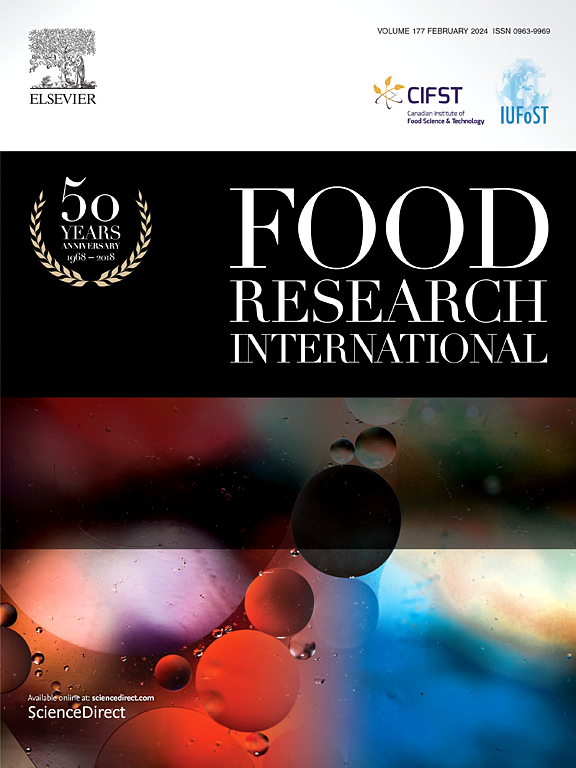Gastrointestinal stability and DPP-IV inhibitory activity of tilapia (Oreochromis niloticus) viscera hydrolysate-derived novel peptides LPCL and TPFLPDE, with LPCL-modulated GLP-1 and PepT1 expression in STC-1 cells
IF 7
1区 农林科学
Q1 FOOD SCIENCE & TECHNOLOGY
引用次数: 0
Abstract
Dipeptidyl-peptidase (DPP)-IV inhibition by penultimate N-terminus Pro-containing peptides is a promising strategy for Type 2 diabetes (T2D) management, as it prevents the degradation of incretin hormones (DPP-IV substrates) like glucagon-like peptide-1 (GLP-1), thereby prolonging their half-life. However, the stability and bio-accessibility of these peptides are crucial to their efficacy in orally administered therapeutics. We previously identified LPCL and TPFLPDE peptides from tilapia viscera by-products hydrolysates, which exhibited significant DPP-IV inhibition in vitro and in situ while effectively preserving active GLP-1 levels after 2 h treatment in STC-1 cells under basal glucose conditions. In this study, we assessed the gastrointestinal (GI) stability of these peptides using a static in vitro GI digestion model and evaluated their DPP-IV inhibition capacity after post-GI digestion and post-DPP-IV pre-incubation. Our findings revealed that both peptides retained their DPP-IV inhibition capacity after GI digestion, with RP-HPLC and mass spectrometry confirming their intact forms. At post-DPP-IV pre-incubation, peptides exhibited decreased DPP-IV inhibition potency, indicating a substrate-type inhibition mechanism, forming N-terminal dipeptide fragments. Furthermore, we extended our previous findings by demonstrating that LPCL not only inhibits DPP-IV activity but also modulates GLP-1 expression and increases PepT1 protein levels in STC-1 cells. Unlike glycyl sarcosine, a known PepT1 substrate, LPCL effectively activates the PepT1 extracellular domain (ECD), leading to increased receptor expression and receptor-ligand interactions, as confirmed by molecular docking analysis. These results provide novel insights into the functional roles of LPCL in modulating DPP-IV activity and GLP-1 expression, potentially via PepT1 ECD conformational stabilization.

罗非鱼内脏水解液衍生的新型肽LPCL和TPFLPDE的胃肠稳定性和DPP-IV抑制活性,LPCL调节STC-1细胞中GLP-1和PepT1的表达
第二n端含前肽抑制二肽基肽酶(DPP)-IV是治疗2型糖尿病(T2D)的一种很有前途的策略,因为它可以防止胰高血糖素样肽-1 (GLP-1)等肠促胰岛素激素(DPP-IV底物)的降解,从而延长其半衰期。然而,这些肽的稳定性和生物可及性对其口服治疗的有效性至关重要。我们之前从罗非鱼内脏副产物水解物中鉴定出LPCL和TPFLPDE肽,它们在体外和原位均表现出显著的DPP-IV抑制作用,同时在基础葡萄糖条件下STC-1细胞中处理2小时后有效保持活性GLP-1水平。在这项研究中,我们使用静态体外胃肠道消化模型评估了这些肽的胃肠道(GI)稳定性,并评估了它们在胃肠道消化和DPP-IV预孵育后的DPP-IV抑制能力。我们的研究结果表明,这两种肽在胃肠道消化后仍保持其DPP-IV抑制能力,RP-HPLC和质谱证实了它们的完整形态。在DPP-IV预孵育后,肽表现出降低的DPP-IV抑制效力,表明底物型抑制机制,形成n端二肽片段。此外,我们扩展了之前的研究结果,证明LPCL不仅抑制DPP-IV活性,还调节GLP-1的表达,增加STC-1细胞中的PepT1蛋白水平。与已知的PepT1底物甘氨酸肌氨酸不同,LPCL有效激活PepT1胞外结构域(ECD),导致受体表达和受体-配体相互作用增加,这一点得到了分子对接分析的证实。这些结果为LPCL在调节DPP-IV活性和GLP-1表达中的功能作用提供了新的见解,可能通过PepT1 ECD构象稳定。
本文章由计算机程序翻译,如有差异,请以英文原文为准。
求助全文
约1分钟内获得全文
求助全文
来源期刊

Food Research International
工程技术-食品科技
CiteScore
12.50
自引率
7.40%
发文量
1183
审稿时长
79 days
期刊介绍:
Food Research International serves as a rapid dissemination platform for significant and impactful research in food science, technology, engineering, and nutrition. The journal focuses on publishing novel, high-quality, and high-impact review papers, original research papers, and letters to the editors across various disciplines in the science and technology of food. Additionally, it follows a policy of publishing special issues on topical and emergent subjects in food research or related areas. Selected, peer-reviewed papers from scientific meetings, workshops, and conferences on the science, technology, and engineering of foods are also featured in special issues.
 求助内容:
求助内容: 应助结果提醒方式:
应助结果提醒方式:


